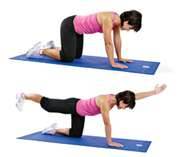Let’s say you’re a middle-of-the-pack 5K runner. You probably spend five or six hours a week doing a weekend long run, one or two speed workouts, and the social group/recovery runs. Maybe you do an hour, perhaps two, of cross-training, which could be swimming, spinning or pumping iron at the local gym. But you feel compelled to add a little "something-something" to your training regimen which will improve your 5K time, if you only knew what would be the most efficient use of your time.
Maybe someone suggested you work on your core – the muscles at the abdomen, hips, and back which transform that slinky of our human spine into something a little more resilient. Is focusing on your core really help you run better? How do you know if your core is strong? And what kind of exercises will give me a strong core?
Sato and Mokha (Journal of Strength & Conditioning Research, Vol.23, Ed.1, 2009) placed a group of runners on a six-week core strength training program to see whether their run performance, ground reaction force (how their limbs contacted the running surface), and lower extremity stability would improve. Both the control and the treatment groups improved their 5K time at the end of the six-week study (which the researchers attributed to several variables), but the group which was placed on the core strength training program had a greater run time improvement, and no perceived change in stride mechanics (from ground reaction force variables) or lower leg stability.
What differed from previous studies on the benefits of core strength training was the higher training volume (four times rather than two a week in other studies), as well as a two-week progression in set volume; the subjects continually had to adapt to an increased stimulus. The exercises used in the study included:
Abdominal crunch on a stability ball. Sit on the ball with your feet flat on the floor at about shoulder-width apart. Place your arms crossed on your chest, or hands behind your head. Walk your feet out a few steps until your lower back is on the ball, then curl your torso up until your shoulders are up off the ball. Hold the position for a moment, then lower and repeat.
Back extension on a stability ball. Lie prone, with your upper torso draped over the ball, and your fingers and toes on the floor. Extend your spine and lift your head and your chest. Return to the starting position.
Supine opposite arm/leg raise. Begin on your hands and knees. Your hands are directly under your shoulders and your knees are directly under your hips at right angles to the floor. Make your legs and feet parallel and hip distance apart. Take a moment to slide your scapula (wing bones) down your back so that your shoulders are away from your ears, your chest is open, and your scapula are settled on your back, not poking up. Extend your right arm straight in front of you and your left leg straight behind you at the same time. Your arm and leg will be parallel to the floor. This is the pose that reminds some people of a bird dog.
Hip raise on a stability ball. Start by lying down, arms out, palms facing down. Rest the lower legs on the ball. Lift the hips upward until the body is straight. Slowly return to the starting position.
Russian twist on a stability ball. Lay on ball, with shoulder blades on ball and hips pushed up high off ground. Place hands together, or hold a single dumbbell. Keeping your hips up, turn your shoulders to the right so they are perpendicular to the ground. Twist back to the starting position, then twist to the other side.
I have bad news and good news about core workouts.
First, the bad news: While core strength training may be an effective training method for improving performance in runners, you might end up with not much more than a strong set of core muscles. When I reviewed the Outside magazine “Ten Biggest Fitness Myths” article, the question was raised whether whether core-specific training benefits athletic performance at all. In one study, a group of collegiate rowers who added an eight-week regimen of core exercises to their regular rowing workouts wound up with stronger cores, but their rowing performances remained the same. A group of Division I varsity football players were also tested, and researchers found almost no correlation between a strong core and athletic performance.
The good news is not only that the the law of specificity still works - running not only can help make you a better runner- but new studies show that running does work your midsection.
Six-pack abs, and a better 5K time. Gee, what a great idea!







No comments:
Post a Comment